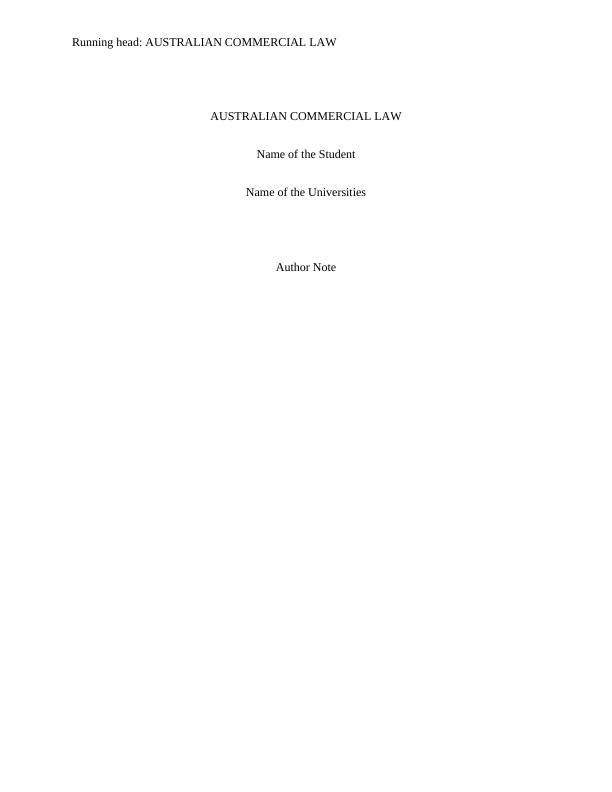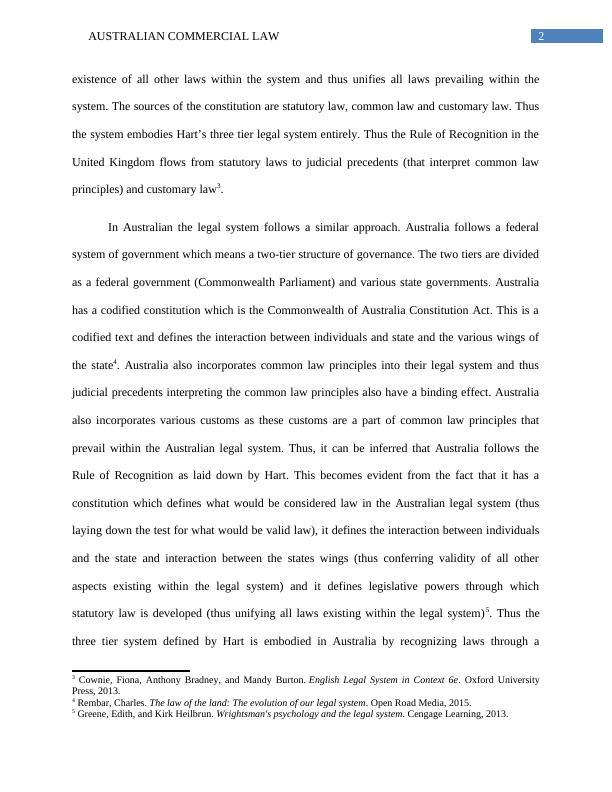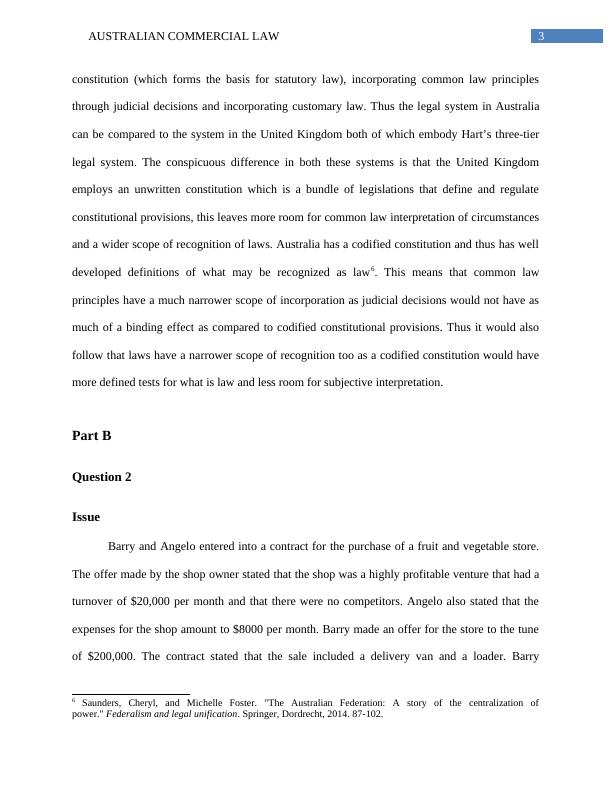Australian Commercial Law: Rule of Recognition and Remedies for Breach of Contract
15 Pages4012 Words437 Views
Added on 2023-06-13
About This Document
This article discusses the Rule of Recognition in Australian Commercial Law and compares it to the legal system in the United Kingdom. It also explores the remedies available for breach of contract under common law principles and the Sale of Goods Act, 1954.
Australian Commercial Law: Rule of Recognition and Remedies for Breach of Contract
Added on 2023-06-13
ShareRelated Documents
Running head: AUSTRALIAN COMMERCIAL LAW
AUSTRALIAN COMMERCIAL LAW
Name of the Student
Name of the Universities
Author Note
AUSTRALIAN COMMERCIAL LAW
Name of the Student
Name of the Universities
Author Note

1AUSTRALIAN COMMERCIAL LAW
Part A
Question 1 (b)
H.L.A Hart in his book the concept of law laid down what is known as the “Rule of
Recognition”. This rule states three requisites which need to be made for a rule to become a law.
These are1:
To establish a test for a valid legal provision in the legal system.
Confer validity to everything else that exists within the applicable legal system.
To unify all laws prevailing within the applicable legal system.
This basically meant the use of a three tier system which identifies what constitutes law
in such a system. This would usually use a descending order structure that flows from Statutes to
Judicial precedents (common law) to customs.
The legal system in the United Kingdom closely follows the demarcations made in the
Rule of Recognition. This means the legal system embodies the three tier system. The United
Kingdom does not have a codified constitution. The British Constitution is a sum of legislations
that have been enacted over the years. These legislations define the relationship between
individuals and the state and the functioning of/the interaction between the executive, legislature
and judiciary2. This firstly lays down what would be a valid law in the legal system following the
various legislations thus the first criteria is met. The constitutional legislations provide for the
division of powers of the various wings and the subjects that maybe legislated on thereby
conferring validity on all laws that exist within the system. The constitution acts as a basis for the
1 Loughlin, Martin, and Samuel Tschorne. Public law. Routledge, 2016.
2 Wilson, Steve, et al. English Legal System. Oxford University Press, 2014.
Part A
Question 1 (b)
H.L.A Hart in his book the concept of law laid down what is known as the “Rule of
Recognition”. This rule states three requisites which need to be made for a rule to become a law.
These are1:
To establish a test for a valid legal provision in the legal system.
Confer validity to everything else that exists within the applicable legal system.
To unify all laws prevailing within the applicable legal system.
This basically meant the use of a three tier system which identifies what constitutes law
in such a system. This would usually use a descending order structure that flows from Statutes to
Judicial precedents (common law) to customs.
The legal system in the United Kingdom closely follows the demarcations made in the
Rule of Recognition. This means the legal system embodies the three tier system. The United
Kingdom does not have a codified constitution. The British Constitution is a sum of legislations
that have been enacted over the years. These legislations define the relationship between
individuals and the state and the functioning of/the interaction between the executive, legislature
and judiciary2. This firstly lays down what would be a valid law in the legal system following the
various legislations thus the first criteria is met. The constitutional legislations provide for the
division of powers of the various wings and the subjects that maybe legislated on thereby
conferring validity on all laws that exist within the system. The constitution acts as a basis for the
1 Loughlin, Martin, and Samuel Tschorne. Public law. Routledge, 2016.
2 Wilson, Steve, et al. English Legal System. Oxford University Press, 2014.

2AUSTRALIAN COMMERCIAL LAW
existence of all other laws within the system and thus unifies all laws prevailing within the
system. The sources of the constitution are statutory law, common law and customary law. Thus
the system embodies Hart’s three tier legal system entirely. Thus the Rule of Recognition in the
United Kingdom flows from statutory laws to judicial precedents (that interpret common law
principles) and customary law3.
In Australian the legal system follows a similar approach. Australia follows a federal
system of government which means a two-tier structure of governance. The two tiers are divided
as a federal government (Commonwealth Parliament) and various state governments. Australia
has a codified constitution which is the Commonwealth of Australia Constitution Act. This is a
codified text and defines the interaction between individuals and state and the various wings of
the state4. Australia also incorporates common law principles into their legal system and thus
judicial precedents interpreting the common law principles also have a binding effect. Australia
also incorporates various customs as these customs are a part of common law principles that
prevail within the Australian legal system. Thus, it can be inferred that Australia follows the
Rule of Recognition as laid down by Hart. This becomes evident from the fact that it has a
constitution which defines what would be considered law in the Australian legal system (thus
laying down the test for what would be valid law), it defines the interaction between individuals
and the state and interaction between the states wings (thus conferring validity of all other
aspects existing within the legal system) and it defines legislative powers through which
statutory law is developed (thus unifying all laws existing within the legal system)5. Thus the
three tier system defined by Hart is embodied in Australia by recognizing laws through a
3 Cownie, Fiona, Anthony Bradney, and Mandy Burton. English Legal System in Context 6e. Oxford University
Press, 2013.
4 Rembar, Charles. The law of the land: The evolution of our legal system. Open Road Media, 2015.
5 Greene, Edith, and Kirk Heilbrun. Wrightsman's psychology and the legal system. Cengage Learning, 2013.
existence of all other laws within the system and thus unifies all laws prevailing within the
system. The sources of the constitution are statutory law, common law and customary law. Thus
the system embodies Hart’s three tier legal system entirely. Thus the Rule of Recognition in the
United Kingdom flows from statutory laws to judicial precedents (that interpret common law
principles) and customary law3.
In Australian the legal system follows a similar approach. Australia follows a federal
system of government which means a two-tier structure of governance. The two tiers are divided
as a federal government (Commonwealth Parliament) and various state governments. Australia
has a codified constitution which is the Commonwealth of Australia Constitution Act. This is a
codified text and defines the interaction between individuals and state and the various wings of
the state4. Australia also incorporates common law principles into their legal system and thus
judicial precedents interpreting the common law principles also have a binding effect. Australia
also incorporates various customs as these customs are a part of common law principles that
prevail within the Australian legal system. Thus, it can be inferred that Australia follows the
Rule of Recognition as laid down by Hart. This becomes evident from the fact that it has a
constitution which defines what would be considered law in the Australian legal system (thus
laying down the test for what would be valid law), it defines the interaction between individuals
and the state and interaction between the states wings (thus conferring validity of all other
aspects existing within the legal system) and it defines legislative powers through which
statutory law is developed (thus unifying all laws existing within the legal system)5. Thus the
three tier system defined by Hart is embodied in Australia by recognizing laws through a
3 Cownie, Fiona, Anthony Bradney, and Mandy Burton. English Legal System in Context 6e. Oxford University
Press, 2013.
4 Rembar, Charles. The law of the land: The evolution of our legal system. Open Road Media, 2015.
5 Greene, Edith, and Kirk Heilbrun. Wrightsman's psychology and the legal system. Cengage Learning, 2013.

3AUSTRALIAN COMMERCIAL LAW
constitution (which forms the basis for statutory law), incorporating common law principles
through judicial decisions and incorporating customary law. Thus the legal system in Australia
can be compared to the system in the United Kingdom both of which embody Hart’s three-tier
legal system. The conspicuous difference in both these systems is that the United Kingdom
employs an unwritten constitution which is a bundle of legislations that define and regulate
constitutional provisions, this leaves more room for common law interpretation of circumstances
and a wider scope of recognition of laws. Australia has a codified constitution and thus has well
developed definitions of what may be recognized as law6. This means that common law
principles have a much narrower scope of incorporation as judicial decisions would not have as
much of a binding effect as compared to codified constitutional provisions. Thus it would also
follow that laws have a narrower scope of recognition too as a codified constitution would have
more defined tests for what is law and less room for subjective interpretation.
Part B
Question 2
Issue
Barry and Angelo entered into a contract for the purchase of a fruit and vegetable store.
The offer made by the shop owner stated that the shop was a highly profitable venture that had a
turnover of $20,000 per month and that there were no competitors. Angelo also stated that the
expenses for the shop amount to $8000 per month. Barry made an offer for the store to the tune
of $200,000. The contract stated that the sale included a delivery van and a loader. Barry
6 Saunders, Cheryl, and Michelle Foster. "The Australian Federation: A story of the centralization of
power." Federalism and legal unification. Springer, Dordrecht, 2014. 87-102.
constitution (which forms the basis for statutory law), incorporating common law principles
through judicial decisions and incorporating customary law. Thus the legal system in Australia
can be compared to the system in the United Kingdom both of which embody Hart’s three-tier
legal system. The conspicuous difference in both these systems is that the United Kingdom
employs an unwritten constitution which is a bundle of legislations that define and regulate
constitutional provisions, this leaves more room for common law interpretation of circumstances
and a wider scope of recognition of laws. Australia has a codified constitution and thus has well
developed definitions of what may be recognized as law6. This means that common law
principles have a much narrower scope of incorporation as judicial decisions would not have as
much of a binding effect as compared to codified constitutional provisions. Thus it would also
follow that laws have a narrower scope of recognition too as a codified constitution would have
more defined tests for what is law and less room for subjective interpretation.
Part B
Question 2
Issue
Barry and Angelo entered into a contract for the purchase of a fruit and vegetable store.
The offer made by the shop owner stated that the shop was a highly profitable venture that had a
turnover of $20,000 per month and that there were no competitors. Angelo also stated that the
expenses for the shop amount to $8000 per month. Barry made an offer for the store to the tune
of $200,000. The contract stated that the sale included a delivery van and a loader. Barry
6 Saunders, Cheryl, and Michelle Foster. "The Australian Federation: A story of the centralization of
power." Federalism and legal unification. Springer, Dordrecht, 2014. 87-102.

End of preview
Want to access all the pages? Upload your documents or become a member.
Related Documents
Australian Commercial Law PDFlg...
|12
|3087
|42
Australian Commercial Law : PDFlg...
|12
|2881
|35
Assignment: Australian Commercial Lawlg...
|13
|3317
|43
Australian commercial Law (PDF)lg...
|13
|2875
|33
Corporate and Commercial Law : Assignmentlg...
|12
|2687
|24
Understanding Separation of Powers and Division of Powers in the Australian Legal Systemlg...
|7
|1653
|463
